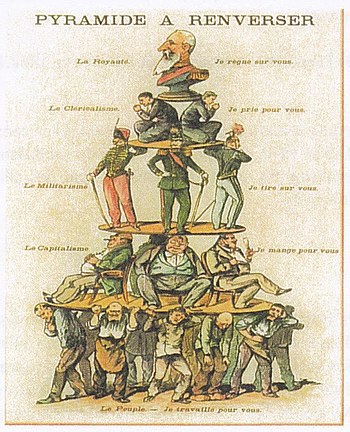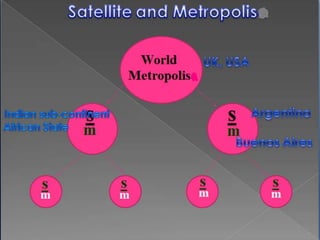Andrea Gunder Frank, like Baran, was interested in identifying the causes of underdevelopment, but unlike his predecessor he did not lay great emphasis on the social classes and their control over the economic surplus (Frank 1967). Rather, Frank argued that the crucial mechanism for extraction of the surplus was trade and other kinds of exchange of goods and services, not only international trade, but also exchange internally in the peripheral societies.
Frank rejected the dualist conception according to which the underdeveloped countries comprised two separate economies, one modern and capitalist and another traditional and non-capitalist. On the contrary, he claimed that capitalism permeated the whole of the periphery to such an extent that the Latin American and other peripheral societies had become integrated parts of a one-world capitalist system after the first penetration by metropolitan merchant capital. This had established capitalist exchange relations and networks that linked the poorest agricultural labourers in the periphery with the executive directors of the large corporations in the USA.
The exchange relations and the network were described by Frank as a pyramidal structure with metropoles and satellites. The agriculture,' labourers and the small farmers in the rural regions of the periphery were satellites at the bottom. They were kinked, mainly through trade, to the landowners and local centres of capital accumulation that is local metropoles. There is turn, were satellites in terms of regional economic elites and centres of surplus extraction. in this way the structure grew —through several links — until it reached the ruling classes and world centres of capitalism in the USA. Throughout this pyramidal structure surplus was appropriated by the centres which, in turn, were subject to the surplus extraction activities of higher level centres.
 |
| Wikipedia Image |
According to Frank, empirical evidence showed that the economic surplus generated in Latin America was drained away. Instead of being used for investment in the countries of origin, most of the surplus was transferred to the affluent capitalist countries, especially the USA. Frank's basic point was that the satellites would be developed only to the extent and in the respects which were compatible with the interests of their metropoles.
And here experience showed, according to him, that neither the USA nor the other industrialized countries had any interest in genuine development of the Latin American countries. Much indicated in fact that precisely those countries and regions which had the closest links to the industrialized countries were the proportionally least developed. Therefore, the explanation of under development lay primarily in the metropole — satelite relations, which not only blocked economic progress, but also often actively underdeveloped the backward areas further (this being a process and not a state).
Frank derived from this the much debated conclusion that all countries in Latin America as well as other Third World countries — would be better off if they disassociated themselves from, or totally broke the links to, the USA and the °thee industrialised countries. De-linking from the world market was the best development strategy_ This presupposed the introduction of some form of socialism in the peripheral countries, because the ruling classes, the landowners and the comprador capitalists could not be expected to bring about such a de-linking and thus remove the foundation for their own surplus generation.
Frank's conclusions, according to both contemporary and later critics, were often drawn further than the analyses warranted. However, this did not prevent his fundamental views and conceptions from winning wide dissemination and achieving considerable impact upon the development debate throughout most of the 1970s.
Frank's position in this regard came to resemble that of Rostov in the sense that they both, for more than a decade, functioned as major reference points in the debates on dependency and economic grow respectively. Like Rostov, whose position was gradually superseded by more nuanced and empirically better substantiated theories within his research tradition, Frank eventually was replaced by more complex and differentia" attempts at explaining the reasons for underdevelopment and its dynamics. One of the earliest attempts in this direction came from Sarnir Amin.
Amin was one of the first economists from the Third World who acquired a prominent international position in the development debates, including the debates in Western Europe and North America. Two of this academic works, in particular, contributed to this prominence: Accumulation on a World Scale, and unequal development.
While Frank chiefly concerned with the conditions and relations of production. Based on thorough historical analysis of how Europe had under developed large parts of Africa in the colonial era, Amin worked out two idea-type societal models with the main emphasis on the structuring of production processes. One model described as auto-centric centre economy; the other a dependent peripheral economy.
The model of auto centric economy has features similar to those included in Rostow's description of the industrialised countries in the epoch of high mass consumption. The auto centric reproduction structure is characterized by the manufacturing of both means of production and goods for mass consumption, Furthermore, the two sectors are interlinked so that they mutually support each other's growth. Similarly, there is a close link between industry and agriculture. The auto centric economy is general characterised by being self-reliant.
This does not imply self-sufficiency. On the contrary, a highly developed capitalist economy typically engages in extensive foreign trade and other international exchange relations. Bur the economy is auto centric in the sense that the intra-societal linkages between the main sectors predominate and shape the basic reproduction processes. It is the internal production relations hat primarily determine the society's development possibilities arid dynamics.
It is quite a different matter with the peripheral economy. According to Amin, this type of economy is dominated by an 'over-developed' export sector and a sector that produces goods for luxury consumption. There is no capital goods industry, and only a small sector manufacturing goods for mass consumption. There are no development-promoting links between agriculture and industry. The peripheral economy is not self-reliant, but heavily dependent on the world market and the links to production and centres of capital accumulation in the centre countries.
It is further part of the picture of the peripheral economy that it is composed of various modes of production. Capitalism has only penetrated limited parts of the production processes while other parts, and quantitatively greater ones, are structured by non-capitalist modes of production. On this point, Amen's conception is more in line with Baran's mode of reasoning and hence, in opposition to Frank's definition of capitalism, in terms of exchange relations. Amin endorsed the thesis that capitalist dominates the periphery within the sphere of circulation, but he asserted at the same time that pre-capitalist modes of production continue to exist and that they exert considerable influence on the total structure of reproduction.
The distorted production structure in the peripheral countries and their dependence is a result of the dominance of the centre countries. It is the centre countries who, by extracting resources and exploiting cheap labour, have inflicted on the peripheral economies the 'over-developed' export sector. At the same time, the centre countries have prevented the establishment of national capital goods industries and the manufacturing of goods for mass consumption. in these areas the rich countries continue to have a vital interest in selling their goods in the peripheral markets.
If the less developed countries operating under the circumstances are to initiate a development process than can lead them in the direction of an auto centric economy - if they are to achieve growth with at least a minimum of equity in social and spatial terms - then they must break their asymmetrical relationship with the centre countries. In its place they must expand regional cooperation and internally pursue a socialist development strategy.










0 Comments